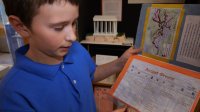A Tool for Documenting Understanding
Travel journals—a mix of notebook and portfolio—allow students to chart and take ownership of their learning.
Your content has been saved!
Go to My Saved Content.Travel journals are student-created “textbooks.” Normal Park calls them travel journals because they chart the journey of students’ learning. They are a great way for students to take ownership of their learning. Every student creates one, and every travel journal is unique to the student.
Travel journals are a collection of the work students do for their science or social studies module. Teachers use travel journals on a daily basis; students create work and then add it to their journal throughout the quarter. Journals include writing and reflection pieces, graphic organizers, timelines, charts, drawings, diagrams, vocabulary, maps, pictures, and anything else that reflects students’ learning and understanding of the module topic. Teachers also photocopy relevant articles and have students place those in their journals.
During the course of one year, a student will create four journals for four different modules. Students take the journals home at the end of each quarter—they love to show them off to their parents and keep them as a record of what they learned.
Creating Content to Deepen the Learning
Students create a variety of content types for their journals––from written reflections to maps and diagrams––in response to teacher prompts and open-ended questions. Each journal project has several essential elements.
Blank journal: At the beginning of each module, teachers hand out a blank journal to each student.
Table of contents: The table of contents is teacher-created and lists 25 to 28 lessons for that module. Students paste the table of contents into their journals on Day 1 of the module.
Essential questions: These three or four open-ended questions are the basis of every lesson taught in the module. Teachers develop the questions according to the standards students must meet in that particular module. For example, a typical question might be “How does where you live affect how you live?” or “How does structure influence behavior?”
Students write in their essential questions at the beginning of the module, placing them on the page opposite the table of contents. This gives them a sense that everything they are exploring in the module is connected to investigating these questions.
“I wonder” questions: On Day 1 of the module, a teacher will deliver a hook lesson introducing students to the module theme. Students are then asked to write their own “I wonder” questions about what they are wondering about the particular module. This is a quick and easy assessment that allows teachers to gauge how much students know about a particular topic.
Content: A travel journal has a variety of content, including graphic organizers, reflection pieces, timelines, charts, diagrams, vocabulary, pictures, maps, and all kinds of writing. Often teachers deliver a lesson and then offer some kind of prompt that students respond to. Each student writes a response, and the teacher helps the student edit it. The final version gets published in the travel journal as a record of the student’s work.
Rubric: A rubric is a simple way for students and teachers to judge the completion of assignments. The lower grades use a simple check minus, check, or check plus to assess learning. In the lower grades, the rubric is a reflection of the table of contents, with an added column for a grade the student gives himself or herself and a column for the grade the teacher gives the student. The rubric for the upper grades can be more specific and sophisticated to reflect what’s being learned.
Cover: Each student designs a cover for his or her journal at the end of the module that reflects an idea related to the topic. Students may have two or three options for themes for the cover they want to draw, paint, or design.
Display: At the end of the quarter, all the travel journals are put on display for the school’s quarterly Exhibit Night. Once the exhibits come down, students receive their journals back and take them home.
Resources:
Normal Park Museum Magnet School
Enrollment
819 | Public, UrbanPer Pupil Expenditures
$9444 School • $9444 District • $9293 StateFree / Reduced Lunch
27%DEMOGRAPHICS:
4% English Language Learners
